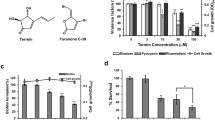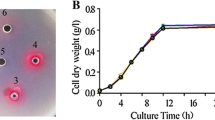Abstract
Siderophore synthesis of Pseudomonas putida F1 was found to be regulated by quorum sensing since normalized siderophore production (per cell) increased 4.2-fold with cell density after the cells entered middle exponential phase; similarly, normalized siderophore concentrations in Pseudomonas aeruginosa JB2 increased 28-fold, and a 5.5-fold increase was seen for P. aeruginosa PAO1. Further evidence of the link between quorum sensing and siderophore synthesis of P. putida F1 was that the quorum-sensing-disrupter (5Z)-4-bromo-5-(bromomethylene)-3-butyl-2(5H)-furanone (furanone) from the marine red alga Delisea pulchra was found to inhibit the formation of the siderophore produced by P. putida F1 in a concentration-dependent manner, with 57% siderophore synthesis repressed by 100 μg/ml furanone. In contrast, this furanone did not affect the siderophore synthesis of Burkholderia cepacia G4 at 20–40 μg/ml, and stimulated siderophore synthesis of P. aeruginosa JB2 2.5- to 3.7-fold at 20–100 μg/ml. Similarly, 100 μg/ml furanone stimulated siderophore synthesis in P. aeruginosa PAO1 about 3.5-fold. The furanone appears to interact with the quorum-sensing machinery of P. aeruginosa PAO1 since it stimulates less siderophore synthesis in the P. aeruginosa qscR quorum-sensing mutant (QscR is a negative regulator of LasI, an acylated homoserine lactone synthase).




Similar content being viewed by others
References
Banin E, Greenberg EP (2003) Iron and Pseudomonas aeruginosa biofilm formation. Pseudomonas 2003, Québec City, Québec, Canada
Bassler BL (1999) How bacteria talk to each other: regulation of gene expression by quorum sensing. Curr Opin Microbiol 2:582–587
Beechan CM, Sims JJ (1979) The first synthesis of fimbrolides, a novel class of halogenated lactones naturally occurring in the red seaweed Delisea fimbriata (Bonnemaisoniaceae). Tetrahedron Lett 19:1649–1652
Boopathi E, Rao KS (1999) A siderophore from Pseudomonas putida type A1: structural and biological characterization. Biochim Biophys Acta 1435:30–40
Chugani SA, Whiteley M, Lee KM, D’Argenio D, Manoil C, Greenberg EP (2001) QscR, a modulator of quorum-sensing signal synthesis and virulence in Pseudomonas aeruginosa. Proc Natl Acad Sci USA 98:2752–2757
Cox CD (1980) Iron uptake with ferripyochelin and ferric citrate by Pseudomonas aeruginosa. J Bacteriol 142:581–587
Cox CD, Adams P (1985) Siderophore activity of pyoverdin for Pseudomonas aeruginosa. Infect Immun 48:130–138
Darling P, Chan M, Cox AD, Sokol PA (1998) Siderophore production by cystic fibrosis isolates of Burkholderia cepacia. Infect Immun 66:874–877
Davies DG, Parsek MR, Pearson JP, Iglewski BH, Costerton JW, Greenberg EP (1998) The involvement of cell-to-cell signals in the development of a bacterial biofilm. Science 280:295–298
DeLisa MP, Valdes JJ, Bentley WE (2001) Quorum signaling via AI-2 communicates the “Metabolic Burden” associated with heterologous protein expression in Escherichia coli. Biotechnol Bioeng 75:439–450
Eberl L, Winson JJ, Sternberg C, Stewart GSAB, Christiansen G, Chhabra SR, Bycroft B, Williams P, Molin S, Givskov M (1996) Involvement of N-acyl-l-homoserine lactone autoinducers in controlling the multicellular behaviour of Serratia liquefaciens. Mol Microbiol 20:127–136
Elasri M, Delorme S, Lemanceau P, Stewart G, Laue B, Glickmann E, Oger PM, Dessaux Y (2001) Acyl-homoserine lactone production is more common among plant-associated Pseudomonas spp. than among soil-borne Pseudomonas spp. Appl Environ Microbiol 67:1198–1209
Givskov M, de Nys R, Manefield M, Gram L, Maximilien R, Eberl L, Molin S, Steinberg PD, Kjelleberg S (1996) Eukaryotic interference with homoserine lactone-mediated prokaryotic signaling. J Bacteriol 178:6618–6622
Gram L, de Nys R, Maximilien R, Givskov M, Steinberg P, Kjelleberg S (1996) Inhibitory effects of secondary metabolites from the red alga Delisea pulchra on swarming motility of Proteus mirabilis. Appl Environ Microbiol 62:4284–4287
Hentzer M, Riedel K, Rasmussen TB, Heydorn A, Andersen JB, Parsek MR, Rice SA, Eberl L, Molin S, Høiby N, Kjelleberg S, Givskov M (2002) Inhibition of quorum sensing in Pseudomonas aeruginosa biofilm bacteria by a halogenated furanone compound. Microbiology 148:87–102
Hentzer M, Wu H, Andersen JB, Riedel K, Rasmussen TB, Bagge N, Kumar N, Schembri MA, Song Z, Kristoffersen P, Manefield M, Costerton JW, Molin S, Eberl L, Steinberg P, Kjelleberg S, Høiby N, Givskov M (2003) Attenuation of Pseudomonas aeruginosa virulence by quorum sensing inhibitors. EMBO J 22:3803–3815
Hickey WJ, Focht DD (1990) Degradation of mono-, di-, and trihalogenated benzoic acids by Pseudomonas aeruginosa JB2. Appl Environ Microbiol 56:3842–3850
Holloway B (1969) Genetics of Pseudomonas. Bacteriol Rev 33:419–443
Lamont IL, Beare PA, Ochsner U, Vasil AI, Vasil ML (2002) Siderophore-mediated signaling regulates virulence factor production in Pseudomonas aeruginosa. Proc Natl Acad Sci USA 99:7072–7077
Lazazzera BA, Grossman AD (1998) The ins and outs of peptide signaling. Trends Microbiol 6:288–294
Lewenza S, Conway B, Greenberg EP, Sokol PA (1999) Quorum sensing in Burkholderia cepacia: identification of the LuxRI Homologs CepRI. J Bacteriol 181:748–756
Manefield M, de Nys R, Kumar N, Read R, Givskov M, Steinberg P, Kjelleberg S (1999) Evidence that halogenated furanones from Delisea pulchra inhibit acylated homoserine lactone (AHL)-mediated gene expression by displacing the AHL signal from its receptor protein. Microbiology 145:283–291
Manny AJ, Kjelleberg S, Kumar N, de Nys R, Read RW, Steinberg P (1997) Reinvestigation of the sulfuric acid-catalysed cyclisation of brominated 2-alkyllevulinic acids to 3-alkyl-5-methylene-2(5H)-furanones. Tetrahedron 53:15813–15826
Meyer JM, Abdallah MA (1978) The fluorescent pigment of Pseudomonas fluorescens: biosynthesis, purification and physicochemical properties. J Gen Microbiol 107:319–328
Miller MB, Bassler BL (2001) Quorum sensing in bacteria. Annu Rev Microbiol 55:165–199
Moat AG, Foster JW (1995) Microbial physiology. Wiley-Liss, New York
Ren D, Wood TK (2004) (5Z)-4-Bromo-5-(bromomethylene)-3-butyl-2(5H)-furanone reduces corrosion from Desulfotomaculum orientis. Environ Microbiol 6:535–540
Ren D, Sims JJ, Wood TK (2001) Inhibition of biofilm formation and swarming of Escherichia coli by (5Z)-4-Bromo-5-(Bromomethylene)-3-Butyl-2(5H)-Furanone. Environ Microbiol 3:731–736
Ren D, Bedzyk LA, Thomas SM, Ye RW, Wood TK (2004) Differential gene expression shows natural brominated furanones interfere with the autoinducer-2 bacterial signaling system of Escherichia coli. Biotechnol Bioeng (in press)
Rice SA, Givskov M, Steinberg P, Kjelleberg S (1999) Bacterial signals and antagonists: the interaction between bacteria and higher organisms. J Mol Microbiol Biotechnol 1:23–31
Shields MS, Montgomery SO, Chapman PJ, Cuskey SM, Pritchard PH (1989) Novel pathway of toluene catabolism in trichloroethylene-degrading bacterium G4. Appl Environ Microbiol 55:1624–1629
Spain JC, Zylstra GJ, Blake CK, Gibson DT (1989) Monohydroxylation of phenol and 2.5 dichlorophenol by toluene dioxygenase in Pseudomonas putida F1. Appl Environ Microbiol 55:2648–2652
Stintzi A, Evans K, Meyer J-M, Poole K (1998) Quorum-sensing and siderophore biosynthesis in Pseudomonas aeruginosa: lasR/lasI mutants exhibit reduced pyoverdine biosynthesis. FEMS Microbiol Lett 166:341–345
Whitehead NA, Barnard AML, Slater H, Simpson NJL, Salmond GPC (2001) Quorum-sensing in gram-negative bacteria. FEMS Microbiol Rev 25:365–404
Acknowledgements
This study was supported by the Electric Power Research Institute (EP-P6965/C3530). We thank Dr. Tim Mcdermott (Montana State University) for his gift of P. aeruginosa PAO1, and Dr. Peter Greenberg (University of Iowa) for sending strains P. aeruginosa PAOR3 and PAOR3/pKL9.
Author information
Authors and Affiliations
Corresponding author
Rights and permissions
About this article
Cite this article
Ren, D., Zuo, R. & Wood, T.K. Quorum-sensing antagonist (5Z)-4-bromo-5-(bromomethylene)-3-butyl-2(5H)-furanone influences siderophore biosynthesis in Pseudomonas putida and Pseudomonas aeruginosa. Appl Microbiol Biotechnol 66, 689–695 (2005). https://doi.org/10.1007/s00253-004-1691-6
Received:
Revised:
Accepted:
Published:
Issue Date:
DOI: https://doi.org/10.1007/s00253-004-1691-6




